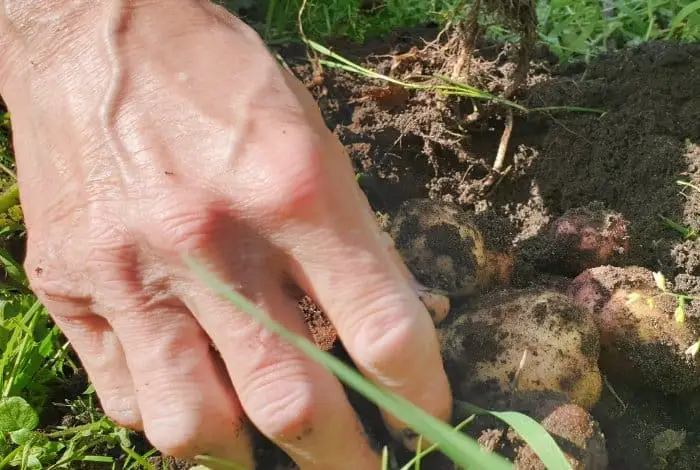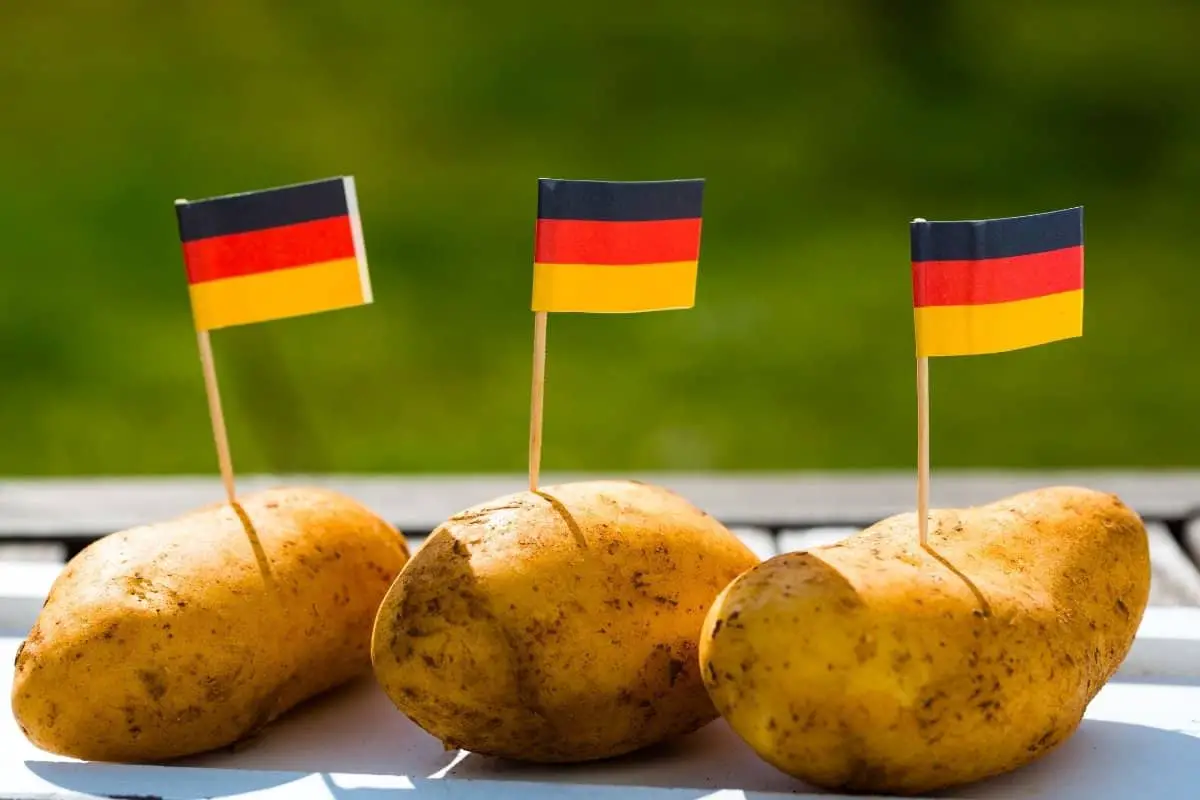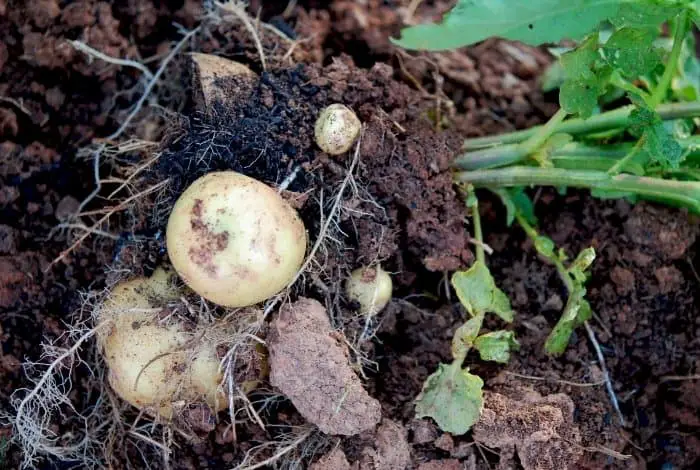Last Updated on January 20, 2022 by
How to Grow German Butterball Potatoes
This potato type is available all year round with its peak season being late spring through late summer. They are known for their cooking versatility and rich flavors. These potatoes will keep for a couple of weeks when stored unwashed in a cool, dark place with good ventilation.
How To Plant
Plant the potatoes directly in the garden as soon as they have roots. Potatoes are a cool-season crop that should be planted before the frost season. Potatoes are also grown as a fall crop in milder regions.
Select a location that receives full sun with rich moist organic soil. To avoid disease problems, do not plant these potatoes where you had planted tomatoes, peppers, potatoes, or eggplant. Avoid using poorly drained soils and be sure the pH level is between 4.8 to 6.0.
Prepare the bed by turning the soil under the depth of 8 inches. Level it with a rake to remove clumps of stones and grass.
Plant the mini tuber in full; do not cut it into smaller pieces. Lay the mini tubers in a trench of about 4-5 inches deep and about 6-8 inches wide. Apply a light fertilizer at the bottom of the trench. Space the potatoes 10 to 12 inches apart with the ‘eyes’ facing up and cover them with 2or 3 inches of soil. The rows should be spaced about 2 feet apart.
When the plants are about 5 inches tall, hill them up with soil from the sides of the trench covering the foliage but allowing at least 2 inches of foliage above the soil.

Continue this hilling process as the plants grow, usually every 2 weeks. The hilling keeps the plant cool and prevents the potatoes from forming near the top surface where the light will cause the tubers to turn green and become poisonous. Hilling also suppresses weeds and keeps the roots deep into the soil where there is most moisture.
Read more about The Ultimate List of Determinate and Indeterminate Potatoes
How to Grow
Keep the weeds under control during this season. Weeds compete with plants for water, nutrients, and space. Control them by either using mulch to prevent their seeds from germinating or cultivating them often. Cultivate with care to avoid bruising the plants or cutting the young tubers below the soil.
Learn How To Store Potatoes From The Garden
Harvesting
Harvest new potatoes as soon as the plants begin to flower as young potatoes or after 15 weeks since planting. Store them in a cool, dark, and dry place for a week at 65 – 70F. Then later store them at 35-40 degrees F in a dark place.
Why Grow German Butterball Potato
We all know potatoes are a critical part of different meals in every home. How about growing your own and eating them as much and as often as you would like?
These potatoes are best suited for applications like baking, steaming, frying, and mashing. They are an all-purpose variety that works well in different dishes – in soups, side dishes, or any other waxy potato recipe. German butterball potato holds its shape well when cooked.
It can be roasted with rosemary and served with toppings like Greek yogurt and mascarpone.
Pairs well with arugula, carrots, basil, leeks, garlic, celery, parsnips, spinach, chicory, peas, cilantro, and chives.
This potato is an excellent source of potassium, fiber, iron, vitamin C, and antioxidants.
FAQs
How long does it take German Butterball potatoes to grow?
German Butterball potatoes are slow-growing varieties that develop flavors as they age, so they can be stored for up to one year without any loss of quality.
Growing these potatoes takes about 70 days and they grow from a small tuber to an average sized potato which is about 3 pounds.
How do you harvest German Butterball potatoes?
In order to harvest German Butterball potatoes, there are specific techniques that you need to know.
First of all, you need to dig a trench around the potato plant. Place the trench at least 3 feet away from the potato plants and fill it with soil or compost. Next, you need to cover the trench with black polyethylene plastic. Covering it will create a greenhouse on top of your trenches and prevent sunlight from entering and causing frost on your plants. Finally, water them thoroughly every day before harvest time starts so they can be ready for picking when they get hot again.
German Butterball potatoes are known for their buttery flavor and dense texture that is perfect for baking, frying, or roasting.
The Spanish scientist Borja Ruiz Camargo developed these potatoes through selective breeding. He crossed two types of potatoes - Russet Burbank and another unnamed potato- to create what is now known as German Butterball.
How big do German Butterball potatoes get?
The average size of German Butterball potatoes is between 10-12 centimeters. They are about the length of a baby’s fist, which means that they are quite small.
German Butterball potatoes grow in great quantities in the United States and Canada. There is also a large number of German Butterball potatoes grown in China and India.
The cultivation of this potato variety started in Germany during the early 1800s; however, it was not until the 1930s when their current size became popular.
Are German Butterball potatoes early or late?
German Butterball potatoes are some of the earliest potatoes you can find on a grocery store shelf. They are also considered to be late potatoes because they are harvested in September when other varieties would have been removed from store shelves for longer periods of time.
What's the best potatoes for mashed potatoes?
Potatoes are a staple in the kitchen, and they can be used in many different dishes. But what type of potato should you use for mashed potatoes?
One of the best options is Yukon Gold potatoes. They come in large sizes and have a smooth texture that makes them perfect for mashing. They also have a high water content which allows them to mash without needing any added liquid.
Some other potatoes that are good for mashed potatoes are Red Bliss, Baking, and Parsnips. These potatoes all have high moisture contents which allow them to mash easily too!
What is the most popular potato in the world?
The most popular potato in the world is the Russet Burbank, which has been cultivated for over a century. It was developed at the University of California, Davis. The Russet Burbank is also known as the "Golden Caviar" or "Caviar of the West."
The Russet Burbank was bred to be able to grow well in chilly weather and have less susceptibility to disease. This variety was also grown in large quantities during World War II when production had to be increased as supplies from other countries were cut off.
Conclusion
FAQs
How long does it take German Butterball potatoes to grow?
German Butterball potatoes are slow-growing varieties that develop flavors as they age, so they can be stored for up to one year without any loss of quality.
Growing these potatoes takes about 70 days and they grow from a small tuber to an average sized potato which is about 3 pounds.
How do you harvest German Butterball potatoes?
In order to harvest German Butterball potatoes, there are specific techniques that you need to know.
First of all, you need to dig a trench around the potato plant. Place the trench at least 3 feet away from the potato plants and fill it with soil or compost. Next, you need to cover the trench with black polyethylene plastic. Covering it will create a greenhouse on top of your trenches and prevent sunlight from entering and causing frost on your plants. Finally, water them thoroughly every day before harvest time starts so they can be ready for picking when they get hot again.
German Butterball potatoes are known for their buttery flavor and dense texture that is perfect for baking, frying, or roasting.
The Spanish scientist Borja Ruiz Camargo developed these potatoes through selective breeding. He crossed two types of potatoes - Russet Burbank and another unnamed potato- to create what is now known as German Butterball.
How big do German Butterball potatoes get?
The average size of German Butterball potatoes is between 10-12 centimeters. They are about the length of a baby’s fist, which means that they are quite small.
German Butterball potatoes grow in great quantities in the United States and Canada. There is also a large number of German Butterball potatoes grown in China and India.
The cultivation of this potato variety started in Germany during the early 1800s; however, it was not until the 1930s when their current size became popular.
Are German Butterball potatoes early or late?
German Butterball potatoes are some of the earliest potatoes you can find on a grocery store shelf. They are also considered to be late potatoes because they are harvested in September when other varieties would have been removed from store shelves for longer periods of time.
What's the best potatoes for mashed potatoes?
Potatoes are a staple in the kitchen, and they can be used in many different dishes. But what type of potato should you use for mashed potatoes?
One of the best options is Yukon Gold potatoes. They come in large sizes and have a smooth texture that makes them perfect for mashing. They also have a high water content which allows them to mash without needing any added liquid.
Some other potatoes that are good for mashed potatoes are Red Bliss, Baking, and Parsnips. These potatoes all have high moisture contents which allow them to mash easily too!
What is the most popular potato in the world?
The most popular potato in the world is the Russet Burbank, which has been cultivated for over a century. It was developed at the University of California, Davis. The Russet Burbank is also known as the "Golden Caviar" or "Caviar of the West."
The Russet Burbank was bred to be able to grow well in chilly weather and have less susceptibility to disease. This variety was also grown in large quantities during World War II when production had to be increased as supplies from other countries were cut off.
German butterball potato is grown like the other potato species but its sweetness exceeds them. The buttery flavor is one that you won’t find in other potatoes, the more reason you need to grow some. And if you love to eat your potatoes for long, it still keeps fresh no matter how long you store it. As long as you store it in perfect conditions!
Caroline is a gardener who loves to get down to the nitty–gritty of gardening. She proudly proclaims herself as a ‘dirt worshipper‘ and can often be found deep in the garden, covered in soil and singing to her plants. As a self–proclaimed ‘plant whisperer‘, Caroline believes that plants need love and attention just like any other living thing, and she loves to give them both. When she‘s not tending to her garden, you can often find her researching the latest gardening trends, or teaching others how to make their gardens thrive




